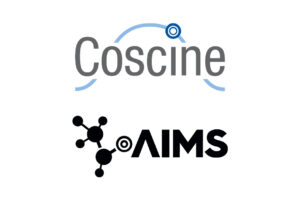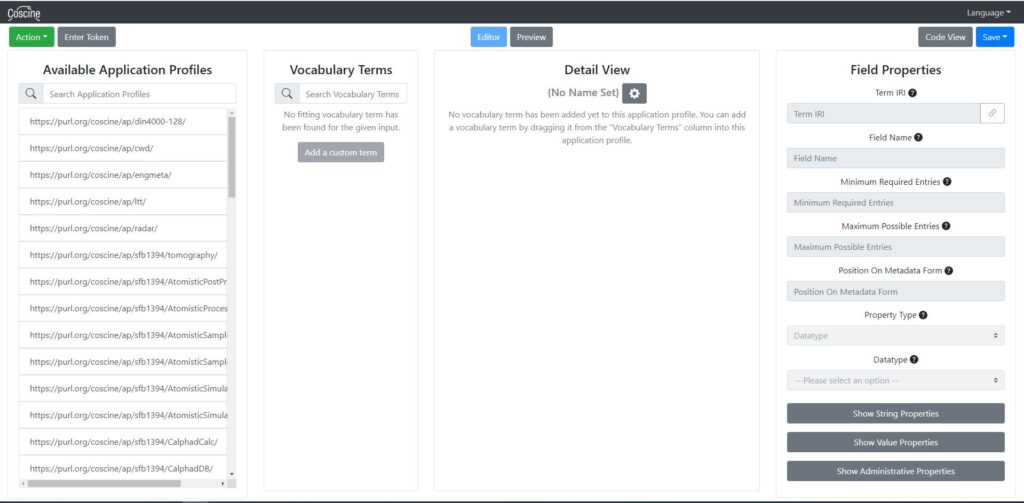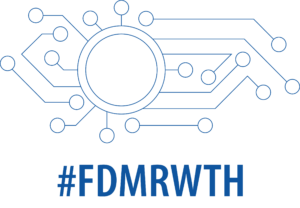Coscine is in constant development. As of this week, it is now possible to create individual application profiles using the integration of the application profile generator from AIMS. The new feature is primarily aimed at data stewards and people familiar with their domain-specific ontologies. What AIMS is and how the creation of application profiles in Coscine works is presented in this article.
What is AIMS?
Back in June 2020, we reported on the approval of the Applying Interoperable Metadata Standards (AIMS) project. AIMS is a DFG-funded project from an interdisciplinary team consisting of the institutions:
- Laboratory for Machine Tools and Production Engineering (WZL),
- IT Center (ITC) of RWTH Aachen University
- Chair of Fluid Systems (FST)
- University and State Library (ULB) of TU Darmstadt.
AIMS aims to create a central infrastructure and tools for FAIR metadata management. This includes, among other things, the development of an application profile generator to create interoperable metadata schemas based on established and controlled terminologies. In addition, there will be a public platform for searching metadata and an integrative interface for researchers. Created application profiles and validated metadata will be made available so that they can be embedded in scientific workflows and disseminated for maximum reuse.
AIMS in Coscine
From now on the application profile generator of AIMS is available in Coscine for the creation of user-defined application profiles. Through a user-friendly interface, individual application profiles can now be created, which are automatically formulated in SHACL and translated into RDF data format. This format allows users to define the structure of their metadata while making the data interoperable and machine-readable according to FAIR principles. The Application Profile Generator thus supports users in research data management, since in-depth knowledge of SHACL and RDF data format is not mandatory for its use.
The application profile generator can be accessed in Coscine at this link.
When creating a new application profile, the generator searches for already existing terms in established metadata schemas. For example, if a field with a date is to be added to one’s application profile, the search bar can be searched for the keyword “date” and an already established and linked term can be added to the application profile. The search function currently searches all ontologies of the NFDI4Ing Terminology Service. It is planned to extend the search function to other ontology databases.
If a desired term is not found during the search in the NFDI4Ing Terminology Service, it is still possible to insert it into one’s own application profile and link it to the correct subject-specific ontology. Using the search engines for ontologies (e.g., Prefix Zazuko or Linked Open Vocabularies), the appropriate URLs for almost any desired term can be found and then inserted into the application profile generator. At this point, using the generator requires some RDM expertise in selecting a suitable ontology.
Self-created application profiles can be downloaded in RDF format and sent to Coscine for publication. Prior to publication on Coscine, the Coscine and RDM team will verify technical functionality and linking of new terms from established ontologies.
Feedback welcome
We are very happy to receive questions and comments about the Application Profile Generator. Feel free to try it out and contact the ServiceDesk with your feedback.
Learn more
You can find a comprehensive documentation on the Application Profile Generator on the website of Coscine.
If you have any questions about AIMS and Coscine or about RDM in general, simply write a message to the ServiceDesk. The RDM team looks forward to hearing from you.
For more information on RDM, please also visit the RWTH web pages.
_______
Responsible for the content of this article is Arlinda Ujkani.







Leave a Reply
You must be logged in to post a comment.